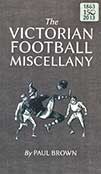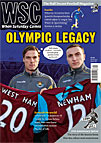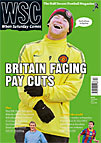Search: 'goal-line technology'
Shop
Stories
 by Paul Brown
by Paul Brown
Goal-Post, £7.99
Reviewed by Terry Staunton
From WSC 318 August 2013
Pre-empting the terrace chants of several future generations, the 1878 FA Cup final referee was, indeed, a Bastard. Racehorse owner and solicitor Segar Bastard was the man with the whistle, although just a few years earlier he might have been waving a handkerchief to signal foul play, before a bright spark hit on the idea that something which made a noise might more easily attract players’ attention.
It sounds like an obvious tweaking of how the game should be played, along with the 1871 ruling that introduced dedicated goalkeepers – instead of anyone on the pitch being allowed to take a “fair catch” – although it would be another 40 years before keepers’ powers were reined in to prevent them from picking the ball up anywhere in their own half. Likewise, the Victorian equivalent of goal-line technology was the 1870s introduction of solid crossbars, thus ending the confusion and controversy caused by balls striking the strip of tape tied between the tops of posts.
Paul Brown’s miscellany doesn’t attempt a straight chronology of how the game developed while Queen Victoria was on the throne, and that is to the book’s advantage. The time-hopping scattergun collection of pivotal changes to the laws governing play is liberally peppered with tremendously trivial tales of Zulu warriors playing exhibition matches in Scarborough, newspaper reports of therapeutic games played between inmates of lunatic asylums and revelations about the health-conscious 1889 Sunderland team containing seven non-smokers.
The author’s visits to press archives come up trumps time and again, recounting St Patrick’s Day riots at an 1840 match in Edinburgh (“a reinforcement of the police soon dispersed the cowardly assailants; four of the ringleaders, we are happy to say, are in custody”) or Derby Council’s decision to ban the game outright in 1846, declaring it “a vestige of a semi-barbarous age”. And who wouldn’t have wanted to witness the game played in Windsor, when both teams had their ankles tied 15 inches apart and the winners were presented with a cheese?
Among these myriad curios, Brown offers potted biographies of pioneering teams, players and personalities. Modern-day fans of Notts County may already be well versed in the club’s history but it’s intriguing for the rest of us to learn that antagonisms with their Forest neighbours stretch back to the very first derby fixture, when the latter team sneakily fielded 17 players. Rightful space is afforded to such movers and shakers as first FA secretary Ebenezer Cobb Morley, aristocratic Arthur Kinnaird (a 19th-century David Beckham, suggests Brown) and poet Nevill “Nuts” Cobbold, regarded as the forefather of dribbling.
The rules may have varied from town to town, even factory to factory, before the FA sought workable unification, while outbreaks of violence meant football habitually filled as many column inches of the crime reports as it did the sports pages, but the colourful transitions the game went through to become the beast we know today are endlessly fascinating. This book doesn’t set out to tell the story in dense, sober detail, opting instead to present itself as a hugely entertaining exercise in eavesdropping.
 Dear WSC
Dear WSC
I was delighted to see my one and only childhood football video, 101 Great Goals, revisited in WSC 288’s Screen Test – and glad to find I’m not the only one ever bemused by its inclusion of Jimmy Greaves’ perfunctory toepoke next to the legendary moments of brilliance from Ronnie Radford, Ernie Hunt and (“…and still”) Ricky Villa. I was reminded, though, of the occasion a decade or so back when I dug my copy out – for the first time in a good while – to share with some contemporaries; we got about sixty goals in before they said, “You know, these are nothing special, we’re a bit bored now”. It was shocking to realise, yet I was maybe even thinking it slightly myself; what had seemed so glorious as recently as the mid-’90s could now appear workaday only a few years later. An average Match of the Day now contains as impressive a collection of netbusters as you’d find in any sample of 20-odd “all-time great'” goals on this tape. Shorn of the rosy tint, quite a few of those cherry-picked highlights from 1969-87 look startlingly unexceptional today. I feel sorry for the youngest fans who have never known anything else and so presumably will soon be unable to comprehend what all the fuss was about George Best or Charlie George. Personally, I’m rather glad I caught the tail end of the era in which that action was still considered remarkable, and hence was able to enjoy this video for many years; it was the best single source of classic-football education I ever had.
David Leverton, South Wales
Dear WSC
Following on from recent letters regarding annoying phrases of commentators and pundits, I’m mystified by the unofficial scale measuring the certainty of a penalty decision. Whether it’s a “stonewaller”, “nailed-on”, “stick-on” or merely just “I’ve seen ‘em given”, the rubbish babbled out is bizarre. I’m tempted to make up my own such as a “garden-fencer” or “sellotaped-on” but I might sound as big a berk as Andy Townsend.
Ian Taylor, Ipswich
Dear WSC
Regarding Ian Plenderleith’s article about TV commentators in WSC 289, we are seeing far more soccer on TV here in the US due to Fox and ESPN. The last thing we want to see is the commentary taken over by home-grown Americans, because if you’ve ever heard an American Football game called on the TV you’d know these guys can drone on relentlessly for the three hours without barely taking a breath. Considering that Sky have some guy who says the word “quality” every third word (and never pronouncing the “t”) Darke and McManaman are not that bad. My only criticism, which has made me hit the mute several times, is McManaman’s propensity to say “isn’t”, “wasn’t it”, or “hasn’t it” at the end of virtually everything he says.
Ian Orme, Fort Collins Colorado
Dear WSC
I take slight umbrage at James Thomson’s review of 101 Greatest Goals in WSC 288. He mentions Graeme Sharp’s astonishing strike for Everton v. Liverpool in 1984, and then makes the heinous mistake of suggesting the match took place at Goodison when, in fact, it took place at Anfield, where Everton hadn’t won for 14 years. As an Evertonian, I have to point that out by law. However, perhaps his biggest error was in describing the hero of the afternoon. Rather than veering in from the left, as James suggests, the pitch invading goon quite clearly veers in from the right. I would also disagree with his assertion that the male in question was a “bespectacled middle-aged man” – I would argue that he is in his mid-20s, but his aged look is the result of the “trainspotting-chic” NHS/duffel coated fashion which dominated the scene for a time during the Smiths-era mid 1980s.
Graeme Coleman, Carnoustie
Dear WSC
In his letter in WSC 289, Jeff Hoyle bemoans the Wigan Athletic ticket office for recognising him as a potential hooligan, despite his advanced years and Bury membership card. The club database has been oft-discussed and long-derided for it’s routinely heavy handed application of the rules of ticket purchase, and it’s easy to have some sympathy for Mr Hoyle’s plight, but incidents in the past five seasons have made the officials of Wigan Athletic somewhat paranoid. One first has to consider the geographical location of the town. We are smack bang in the middle of a region which contains six other Premier League clubs within half an hour’s easy drive. Add that to the fact that the club were formed as recently as 1932 and only very recently attained any kind of status in the sport, and the end result is a populace which doesn’t yet automatically see Wigan Athletic as its first club. What this means is that the pubs of Wigan teem with ill-fitting replica shirts every time Man Utd – in particular – are playing. When they play at the DW, of course, the ground often ends up with hundreds of these plastic Mancs sat in the home stands, due to them living in a WN post code area, often leading to outbreaks of fisticuffs as the almost inevitable third or fourth goal goes in. It is because of this that the club operate such a strict application of the database rules. One would hope that common sense would sometimes be applied, but, alas, this is rarely the case, leading to the kind of rejection as suffered by Mr Hoyle.
As an example of why paranoia rules the day, a recent report in the rugby-leaning Wigan press told of another rejection at the ticket office window when a woman, having been challenged on similar grounds to Mr Hoyle, tried to buy tickets for her husband and admitted that he was “both a Wigan and Utd fan”. Not much of a fan, evidently, given that the last game he made the two mile trip to the stadium for was the Utd game last season. Personally, I’d rather see thousands of empty seats than have people like that expecting to be able to buy tickets, having turned their noses up at their home town club for the other 37 games played every season.
Paul Middleton
Dear WSC
With Spurs currently playing Milan in the Champions League, yet again I have to endure English commentators getting the names of the Milan teams wrong. Look, it’s very simple; there are two teams based at the San Siro, Milan and Internazionale. There’s no need to call them “AC Milan” and “Inter Milan” to try and differentiate them. I’ll draw you an analogy; in Liverpool there are two teams, Liverpool and Everton. There’s no need to call them “Liverpool FC” or, even worse, “Everton Liverpool” to differentiate them. That would be daft. Can you see why this is annoying me?
Phil Robbins, Cheltenham
Dear WSC
In the Season In Brief on Division One 2000-2001 (WSC 289) here were many candidates for the “Disappearing from view” section featured in the actual article itself. Ossie Ardiles was last heard of being sacked as manager of Cerro Porteno in Paraguay, Barry Hayles now plays for Truro City in the Southern League Premier Division, Andy Melville is coaching the Oxford Brookes University Football Club, Jason McAteer doing occasional media work for ESPN Star Sports of Singapore and Matt Jansen is with Chorley (one goal in eight games). So well done you for successfully unearthing Colin Calderwood from that pit of obscurity that is Scottish Premier League management.
Tim Curtis, York
Dear WSC
Am I the only person who is driven to despair whenever the FA Cup draw is made? To be specific, it’s the recent trend where Jim Rosenthal or whoever has to announce the “numbers to watch out for”. Why do I need to know the numbers to watch out for when Jim himself will give the names of the teams out about a quarter of a second after the numbers are drawn? Not only that but when, say, number 23, comes out, I can’t remember whether that was Man U, Arsenal, Liverpool, Chelsea or some non league minnow but I know it was one of them. While I am wracking my brain, he then tells me the team so it loses all impact because I was already trying to figure it out anyway. Does this annoy anyone else?
Alan Bunce, Reading
Dear WSC
Until the mid-1990s at least, the little lines that signify the 10-metre distances from the corners used to touch the sidelines and goal-lines, but now they do not, a sliver of green grass separating them. When did this change, and why on earth did it happen?
Denis Hurley, Cork
Dear WSC
Andy Gray may have been shunted into obscure daytime talk radio, but his legacy of being over critical of match officials – male and female – in the TV commentary box will surely live on via lesser regarded imitators. ITV4 coverage of the Europa League game between Benfica and Stuttgart in mid February, involved commentary by the amiable Steve Bower assisted, unfortunately, by Iain Dowie. A first half incident where Benfica had strong claims for a penalty turned down – efficient referee promptly booked the Benfica striker for diving – resulted in Dowie proclaiming that it was a “stonewall” penalty. Replays from different angles showed the striker knocking the ball to the side of the grounded keeper then dropping onto the keeper’s outstretched arm rather than pursuing the loose ball. A reasonably fair call by the ref, but not for Dowie, whose insistence that it was a penalty went on for a few minutes. I senses in Bower’s voice that he felt the ref had called it exactly right but he just couldn’t be bothered arguing the finer points of the replay evidence with Dowie. In the 1970s and 80s Jimmy Hill used his position as TV analyst to highlight poor decisions but I also recall him being pretty fair minded and highlighting the many good calls made by officials. What a shame the majority of our current TV pundits and analysts appear to have lost that reasoned perspective. From 1992 onwards Andy Gray was allowed to develop the approach he became famous for, with multi-angle slow motion replays replacing real time replays and balanced analysis. Our football officials may well continue to bear the brunt of what some would deem to be wholly biased coverage against them.
Mark Alton, Sale
Dear WSC
I’m sure that the stairs out of St James’ Park do not, as the BBC and other broadcasters lead us to believe, go directly out onto the street from Row J or wherever the entrance that we see on match of the day is. Therefore when 4-0 down at home after 25 minutes and after spending fifty plus quid or so to get in, I wonder if I’m alone in thinking that if a TV camera panned onto one of the exits in any ground, during the game, any game – you would see one or two people “leaving”. Or Maybe they’re going to the toilet. Or for a pie. Or a pint. Basically, with all these factors in mind I suppose walking down the exit stairs is much easier to do when you’re four nil down after half an hour (you wouldn’t care about missing anything at this stage granted) but also I’d suspect that these football supporters quite possibly do actually at sometime return to the seat that they’d paid for. I haven’t yet seen any of these blokes interviewed yet by any of the papers or anyone on TV to ask them what they were thinking of which in these days of high technology shouldn’t be hard. You don’t suppose that BBC made it up about people leaving after half an hour to add to the story do you?
Keith Chapman, Leyton
Dear WSC
Keith Chapman’s letter (WSC 289) has inspired me to write regarding my longstanding commentator gripe; the idea that a player’s previous club is in some ways an adjective and impacts on what he is doing at that precise moment in time. You know what I mean, as such a player has a shot on goal we are reminded that he is a former Liverpool player, like that has been a factor in him either accurately hitting the target or putting it way over the bar. The one that we get every single week in the A League is John Curtis, currently of Gold Coast United, but who has been mentioned more times as being a Manchester United player than what he in fact played (thirteen according to Wikipedia) for them.
Ray Kalinauskas, Sydney, Australia
Dear WSC
Enough has been written, by both the informed and the uninformed, about the Gray/Keys/Massey debacle at Sky Sports but, at the risk of continuing a debate long since closed, there is a serious issue overlooked by most coverage. The majority of discussion focussed on the sexist and laddish nature of the comments but very little was made of the attack on an official before a ball was even kicked. What the off-air pre-match discussion shows is the direct attention TV companies put onto officials, waiting for them to make an error (no matter how small) and setting them up as scapegoats. If Liverpool had lost the game no criticism would have been leveled at Kenny Dalglish’s tactics (too fresh and media friendly) nor Fernando Torres’ performance (too big a star) so an official, regardless of gender, is set up as the fall guy. As it was, the dominant order prevailed and the fact that the big decisions were made correctly was overlooked, until the following day. Officials in all televised sports are put in an impossible position by television companies who feel they should be in charge of major decisions. What should be highlighted is the patronizing way television forces this agenda onto viewers by deliberately setting out to belittle those currently responsible. Video replays are only just around the corner in football, TV doesn’t need to keep ridiculing the current administrators to let us know.
Jonathan Paxton, Barton Le Clay
From WSC 290 April 2011
 Dear WSC
Dear WSC
I would like to ask my fellow readers if their clubs have something called “The Nardiello Factor”. The Nardiello Factor is a phenomenon where a striker’s popularity is based in a large part on the exotic nature of his name. At Barnsley we have seen no finer example of this than in recent months with the arrival of Jerónimo Morales Neumann. My fellow Tykes have been beside themselves at the thought of this player, and have wondered how Mark Robins can possibly limit him to just warming the bench. This opinion seems based on nothing more than the fact that he has a name that would be good to shout out when (if) he scores. Our Jerónimo accordingly scores a Nardiello Factor rating of nine (the maximum score is ten). Contrast this with Chris Woods, our loanee from West Brom. He scores a paltry NarFac rating of four. Were he to slightly change his name to Christiano Woodaldo he would up his NarFac rating to eight but, alas, this is not to my knowledge due for consideration. As a consequence the support from the terraces has been a little limited to date. Liam Dickinson scores a NarFac rating of one, though I am willing to concede that, even if he changed his name to Galileo Figaro Magnifico, he’d do well to register a NarFac rating of five. His yellow boots have had a negative impact.
Ian Marsden, Belper
